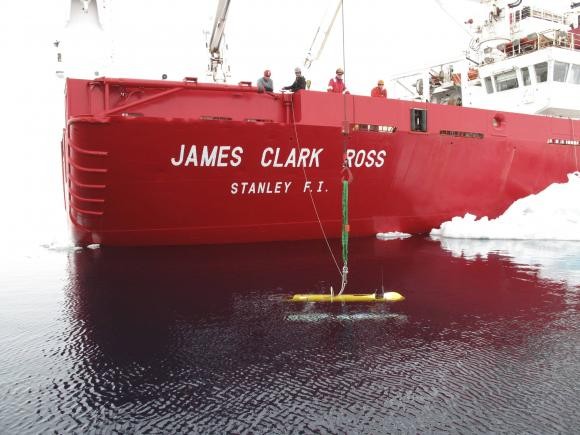Antarctic Sea Ice Thickness Measured by an Underwater Robot
| Marco Foronda | | Nov 25, 2014 02:32 AM EST |
(Photo : REUTERS/BAS/HANDOUT VIA REUTERS) The AUV SeaBED is deployed from British Antactic Survey's, RRS James Clark Ross.
A team of researchers has successfully measured the thickness of Antarctic sea ice for the first time using an Autonomous Underwater Vehicle (AUV) called SeaBED.
"This is the first AUV mission where we could get detailed maps of ice. Working with robots under water is more challenging but there have been significant advances in the technology," according to Ted Maksym, a Woods Hole Oceanographic Institution scientist and co-author of the study.
Like Us on Facebook
SeaBED, a two meter long, state-of-the-art underwater robot, is part of a technological revolution allowing experts to "use aerial and underwater drones to better understand ecosystems". It has built the first detailed, high-resolution 3D maps of Antarctic sea ice.
Polar Oceanographer Dr. Guy Williams of the Institute of Antarctic and Marine Science said "the full 3D topography of the underside of the ice provides a richness of new information about the structure of sea ice and the processes that created it."
SeaBED weighs nearly 200 kilograms; has a twin-hull and mounts a propeller. It was operated remotely at a depth of 65 to 100 feet (20 to 30 meters) in two expeditions; the British Antarctic Survey's RRS James Clark Ross in 2010 and the Australian icebreaker the RSV Aurora Australis in 2012.
Data collected from the AUV indicated the "sea ice was much thicker in some areas than previously thought," Reuters reported.
"The AUV missions have given us a real insight into the nature of Antarctic sea ice. We can now measure ice in far greater detail and were excited to measure ice up to 17 meters (56 feet) thick," said Jeremy Wilkinson, a co-author from the British Antarctic Survey.
Wilkinson added "it is difficult to say whether these findings are positive or negative yet as we have nothing to compare them to but this is the start of the journey."
The study was published in the latest issue of the journal, Nature Geoscience.
TagsUnderwater Robot, SeaBED, RSV Aurora Australis, Antarctic sea, antarctic sea ice, Autonomous Underwater Vehicle
©2015 Chinatopix All rights reserved. Do not reproduce without permission
EDITOR'S PICKS
-

Did the Trump administration just announce plans for a trade war with ‘hostile’ China and Russia?
-

US Senate passes Taiwan travel bill slammed by China
-

As Yan Sihong’s family grieves, here are other Chinese students who went missing abroad. Some have never been found
-

Beijing blasts Western critics who ‘smear China’ with the term sharp power
-

China Envoy Seeks to Defuse Tensions With U.S. as a Trade War Brews
-

Singapore's Deputy PM Provides Bitcoin Vote of Confidence Amid China's Blanket Bans
-

China warns investors over risks in overseas virtual currency trading
-

Chinese government most trustworthy: survey
-

Kashima Antlers On Course For Back-To-Back Titles
MOST POPULAR
LATEST NEWS
Zhou Yongkang: China's Former Security Chief Sentenced to Life in Prison

China's former Chief of the Ministry of Public Security, Zhou Yongkang, has been given a life sentence after he was found guilty of abusing his office, bribery and deliberately ... Full Article
TRENDING STORY

China Pork Prices Expected to Stabilize As The Supplies Recover

Elephone P9000 Smartphone is now on Sale on Amazon India

There's a Big Chance Cliffhangers Won't Still Be Resolved When Grey's Anatomy Season 13 Returns

Supreme Court Ruled on Samsung vs Apple Dispute for Patent Infringement

Microsoft Surface Pro 5 Rumors and Release Date: What is the Latest?










